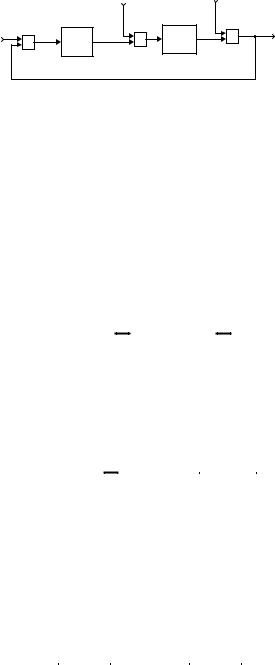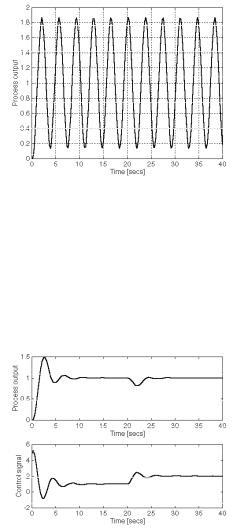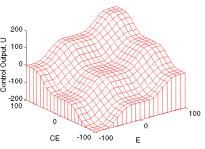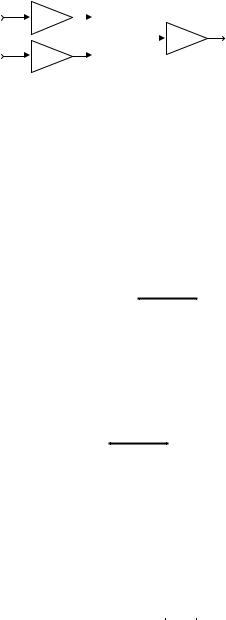
Jantzen J.Tuning of fuzzy PID controllers
.pdf
Tuning Of Fuzzy PID Controllers
Jan Jantzen jj@iau.dtu.dk:1
$EVWUDFW
Since fuzzy controllers are nonlinear, it is more difficult to set the controller gains compared to proportional-integral-derivative (PID) controllers. This research paper proposes a design procedure and a tuning procedure that carries tuning rules from the PID domain over to fuzzy single-loop controllers. The idea is to start with a tuned, conventional PID controller, replace it with an equivalent linear fuzzy controller, make the fuzzy controller nonlinear, and eventually fine-tune the nonlinear fuzzy controller. This is relevant whenever a PID controller is possible or already implemented.
,QWURGXFWLRQ
When the control problem is to regulate the process output around a setpoint, it is natural to consider HUURU as an input, even to a fuzzy controller, and it follows that the integral of the error and the derivative of the error may be useful inputs as well. In a fuzzified PID controller, however, it is difficult to tell the effect of each gain factor on the rise time, overshoot, and settling time, since it is most often nonlinear and has more tuning gains than a PID controller. The objective in this paper is to find a systematic tuning procedure by carrying PID tuning rules over to the fuzzy domain. A systematic tuning procedure would make it easier to install fuzzy controllers, and it might pave the way for auto-tuning of fuzzy controllers.
PID controllers may be tuned in a variety of ways, including hand-tuning, ZieglerNichols tuning, loop shaping, analytical methods, by optimisation, pole placement, or autotuning (Smith, 1979; Åström & Hägglund, 1995). Furthermore, fuzzy controllers show similarities with PID controllers under certain assumptions (Siler & Ying, 1989; Mizumoto, 1992; Qiao & Mizumoto, 1996; Tso & Fung, 1997). But there is still a gap, it seems, between the PID tuning methods and a design strategy for fuzzy controllers of the PID type.
This paper proposes a design strategy, which makes use of known PID design techniques, before implementing the fuzzy controller:
1.Tune a PID controller
2.Replace it with an equivalent linear fuzzy controller
3.Make the fuzzy controller nonlinear
• |
Technical University of Denmark, Department of Automation, Bldg 326, DK-2800 Lyngby, DENMARK. |
|
Tech. report no 98-H 871 (fpid), 30 Sep 1998.
1

l |
n |
|
Ref |
|
|
u |
|
|
x |
y |
|
e |
+ |
|
+ |
|||
|
+ |
|
|
K |
|
+ |
|
|
|
Kp |
+ |
|
|||
|
- |
|
|
|
|
||
|
|
|
|
|
|
|
|
|
|
|
Controller |
|
Process |
|
|
|
|
|
|
|
|
|
Figure 1: Proportional control with load o and noise q.
4. Fine-tune it
It seems sensible to start the controller design with a crisp PID controller, maybe even just a P controller, and get the system stabilised. From there it is easier to go to fuzzy control. Each step will be investigated in the following.
7XQLQJ D 3,' FRQWUROOHU
The first step in the design strategy is to install and tune a PID controller. The ideal continuous PID controller
x @ Ns |
h . Wl ]3 |
w |
h g . Wg gw |
|
(1) |
|
4 |
|
gh |
|
|
returns the controller output x, the constant Ns is the SURSRUWLRQDO JDLQ, Wl is the LQWHJUDO WLPH, Wg the GHULYDWLYH WLPH, and h is the HUURU between the reference and the process output
| +h @ Uhi |,. We are concerned with digital control, and for small sampling periods Wv, the equation may be approximated by a discrete approximation. Replacing the derivative term by a backward difference and the integral by a sum using rectangular integration, an approximation is
q |
s |
3 q |
Wl |
@4 |
m v |
. W |
g |
Wv |
4 |
(2) |
x |
@ N |
h |
. 4 |
q |
h W |
|
hq hq 4 |
|
||
|
|
C |
|
[m |
|
|
|
|
D |
|
Index q refers to the time instant. By WXQLQJ we shall mean the activity of adjusting the parameters Ns> Wl> and Wg=
Several tuning aspects may be illustrated by static considerations (Åström & Hägglund, 1995). For purely proportional control +Wg @ 3 and 4@Wl @ 3,, the control law (2) reduces to
xq @ Nshq |
(3) |
Consider the feedback loop in Fig. 1, where the controller has the proportional gain Ns and the process has the gain N in steady state. The process output { is related to the reference
Uhi> the load o> and the measurement noise q by the equation |
|
||||
{ @ |
NsN |
+Uhi q, . |
N |
(4) |
|
|
|
o |
|||
4 . NsN |
4 . NsN |
||||
2

Controller |
Ns |
Wl |
Wg |
P |
3=8Nx |
|
|
PI |
3=78Nx |
Wx@4=5 |
|
PID |
3=9Nx |
Wx@5 |
Wx@; |
Table 1: The Ziegler-Nichols rules (frequency response method)
If q and o are zero, then Ns should be high in order to ensure that the process output { is close to the reference Uhi= Furthermore, if o is nonzero, a high value will make the system less sensitive to changes in the load o= But if q is nonzero Ns should be moderate, otherwise the system will be too sensitive to noise. If the process dynamics are considered, the closed loop system will normally be unstable if Ns is high. Obviously the setting of Ns is a
balance between the control objectives: stability, noise sensitivity, and load regulation. A PID controller may be tuned using the =LHJOHU 1LFKROV IUHTXHQF\ UHVSRQVH PHWKRG (Ziegler
& Nichols in Åström & Hägglund, 1995). 3URFHGXUH Ziegler-Nichols.
(a)Increase the proportional gain until the system oscillates; that gain is the ultimate gain
Nx.
(b)Read the time between peaks Wx at this setting.
(c)Table 1 gives approximate values for the controller gains.
The sample period may be related to the derivative gain Wg= Åström and Wittenmark (1984) suggest that the sample period should be between 4@43 and 4@5 of Wg. In connection with the Ziegler-Nichols rules, this implies that Wv should approximately equal 4 8 percent of the ultimate period Wx= Another rule says that it should be chosen somewhat smaller than the dominating time constant in the process, for instance between 4@43 and 4@8 of that time
constant.
Ziegler and Nichols also give another method called the UHDFWLRQ FXUYH or VWHS UHVSRQVH method (see for example Åström & Hägglund, 1995). That method uses the open loop step response to find the gains, and this is an advantage if oscillations in the closed loop system cannot be tolerated.
([DPSOH = 1 WXQLQJ $VVXPH WKH SURFHVV LQ )LJ 1 KDV WKH WUDQVIHU IXQFWLRQ
J+v, @
4
+v . 4,6
,QVHUW D 3,' FRQWUROOHU ZLWK GLIIHUHQWLDO DQG LQWHJUDO DFWLRQ UHPRYHG E\ VHWWLQJ Wg @ 3 DQG 4@Wl @ 3= *UDGXDOO\ LQFUHDVH WKH SURSRUWLRQDO JDLQ XQWLO LW UHDFKHV D VWDEOH RVFLOODWLRQ)LJ 2 7KLV JDLQ LV Nx @ ; DQG WKH XOWLPDWH SHULRG LV DSSUR[LPDWHO\ Wx @ 48@7 7KHUH LV D ORDG RQ WKH V\VWHP FI )LJ 1 WKHUHIRUH WKH FRQWUROOHU PXVW FRQWDLQ DQ LQWHJUDWRU 7KH
WKLUG URZ LQ 7DEOH 1 LPSOLHV Ns @ 3=9 Nx @ 7=; Wl @ Wx@5 @ 48@;> DQG Wg @ Wx@; @ 48@65 )LJXUH 3 VKRZV WKH FORVHG ORRS UHVSRQVH DIWHU D VWHS LQ WKH UHIHUHQFH DW WLPH HTXDO
3

Figure 2: Ziegler-Nichols oscillation of process 4@ +4 . v,6 =
Figure 3: PID control of 4@+4 . v,6. A reference step at 3 seconds is followed by a load step at 53 seconds; Ziegler-Nichols tuning.
4

Action |
Rise time |
Overshoot |
Stability |
Increase Ns |
faster |
increases |
gets worse |
Increase Wg |
slower |
decreases |
improves |
Increase 4@Wl |
faster |
increases |
gets worse |
Table 2: Rules of thumb for tuning PID controllers.
WR ]HUR DQG WKH ORDG DIWHU VHFRQGV
Ziegler and Nichols derived the rules for a linear system with a time lag and an integrator. Their design criterion is to obtain a decay ratio of one quarter; GHFD\ UDWLR is the ratio between two consecutive peaks of the error after a step change in reference or load. Thus in a quarter-decay response the second overshoot is 25 % of the first a compromise between a fast response and a small overshoot. The results are poor for systems where the time lag is much greater than the dominating time constant. In general, the rules often result
in rather poor damping, but they do provide the right magnitude of the gains.
A related, more accurate method is .DSSD 7DX WXQLQJ based on the dimensionless parameters: relative gain and relative deadtime (Åström & Hägglund, 1995; Åström, Hang, Persson & Ho, 1992).
The gains found by either method, must sometimes be regarded as approximate values, a starting point for a hand-tuning. Hand-tuning is based on certain rules of thumb used by experienced process engineers (Table 2). The tuning is a compromise between fast reaction and stability. There are exceptions to the rules in the table. If, for example, the process
contains an integrator, an increase in Ns often results in more stable control. The rules of thumb may also be illustrated in WXQLQJ PDSV (see, e.g., Åström & Hägglund, 1995). The
following is a hand-tuning procedure adapted from Smith (1979). 3URFHGXUH Hand-tuning.
(a)Remove all integral and derivative action by setting Wg @ 3 and 4@Wl @ 3.
(b)Tune the proportional gain Ns to give the desired response, ignoring any final value offset from the setpoint.
(c)Increase the proportional gain further and adjust the derivative gain Wg to dampen the overshoot.
(d)Adjust the integral gain 4@Wl to remove any final value offset.
(e)Repeat until the proportional gain Ns is as large as possible.
The procedure adjusts the derivative gain before the integral gain, but in practice the sequence may be reversed. The advantage of hand-tuning is that a process engineer can use the procedure right away, on-line, and develop a feel for how the closed loop system behaves. A disadvantage is that it may take a long time to develop this feel, and it is difficult to sense whether the final settings are optimal.
([DPSOH ,Q D ODERUDWRU\ ZDWHU ULJ WKH FRQWURO REMHFWLYH LV WR DGMXVW WKH ZDWHU OHYHO LQ D WDQN DIWHU D VWHS LQ WKH UHIHUHQFH 7KH ULJ FRQVLVWV RI D IHHG SXPS D WDQN DQG DQ RXWOHW
5

Figure 4: Example of a control surface.
D $VVXPH ILUVW WKDW WKH RXWOHW LV FORVHG )RU WKLV SUREOHP D 3 FRQWUROOHU LV VXIILFLHQW $V VRRQ DV WKH ZDWHU UHDFKHV WKH VHWSRLQW OHYHO WKH HUURU EHFRPHV ]HUR DQG WKH FRQWUROOHU ZLOO VWRS WKH IHHG SXPS SURYLGHG WKH UXOH EDVH LV VHQVLEOH
,I WKHUH LV RYHUVKRRW IRU H[DPSOH LI WKH IHHG SXPS UHDFWV VOXJJLVKO\ WKH FRQWUROOHU VKRXOG VWDUW EUDNLQJ EHIRUH WKH ZDWHU UHDFKHV WKH VHWSRLQW $ 3' FRQWUROOHU LV WKHQ QHFHVVDU\
E $VVXPH QRZ WKDW WKH RXWOHW LV RSHQ 7KH FRQWUROOHU PXVW WU\ DQG UHDFK WKH VHWSRLQW DQG NHHS SXPSLQJ ZKLOH WKH ZDWHU UXQV RXW RI WKH RXWOHW $ VXVWDLQHG FRQWURO VLJQDO LQ VWHDG\ VWDWH LV QHFHVVDU\ WR EDODQFH WKH RXWIORZ ,QWHJUDO DFWLRQ LV QHFHVVDU\ DQG D 3, RU 3,' FRQWUROOHU ZLOO EH DSSURSULDWH
/LQHDU IX]]\ FRQWUROOHUV
The second step in the design procedure is to replace the summation in PID control by a linear fuzzy controller acting like a VXPPDWLRQ. The closed loop system should thus show
exactly the same step response; this is a check that the implementation is correct.
&RQWURO 6XUIDFH With two inputs and one output the input-output mapping is a surface. Figure 4 is a mesh plot of an example relationship between HUURU H and FKDQJH LQ HUURU
FH on the input side, and controller output x on the output side. The plot results from a rule base with nine rules, and the surface is more or less bumpy. The horizontal plateaus are
due to flat peaks on the input sets. The plateau around the origin implies a low sensitivity towards changes in either HUURU or FKDQJH LQ HUURU near the reference. This is an advantage
if noise sensitivity must be low when the process is near the reference. On the other hand, if it is difficult to keep the process on the reference, as with an inverted pendulum, it is necessary to have a larger gain around the origin.
There are three sources of nonlinearity in a fuzzy controller.
7KH UXOH EDVH The position, shape and number of fuzzy sets as well as nonlinear input scaling cause nonlinear transformations. The rules often express a nonlinear control
6
strategy.
7KH LQIHUHQFH HQJLQH If the connectives DQG and RU are implemented as for example PLQ and PD[ respectively, they are nonlinear.
7KH GHIX]]LILFDWLRQ. Several defuzzification methods are nonlinear.
It is possible to construct a rule base with a linear input-output mapping that acts like a summation (Siler & Ying, 1989; Mizumoto, 1992; Qiao & Mizumoto; 1996; Jantzen, 1998).
,QSXW XQLYHUVHV The input universes must be large enough for the inputs to stay within the limits (no VDWXUDWLRQ ). Each input family should contain a number of terms, designed
such that the sum of membership values for each input is 1. This can be achieved when the sets are triangular and cross their neighbour sets at the membership value @ 3=8> their peaks will thus be equidistant. Any input value can thus be a member of at most two sets, and its membership of each is a linear function of the input value.
1XPEHU RI UXOHV The number of terms in each family determines the number of rules, as they must be the DQG combination (RXWHU SURGXFW ) of all terms to ensure completeness.
The output sets should preferably be singletons vl equal to the sum of the peak positions of the input sets. The output sets may also be triangles, symmetric about their peaks, but singletons make defuzzification simpler.
&RQQHFWLYH To ensure linearity, we must choose the algebraic product for the connective
DQG. Using the weighted average of rule contributions for the control signal (corresponding to FHQWUH RI JUDYLW\ defuzzification, &2* ), the denominator vanishes, because all firing
strengths add up to 1.
What has been said can be generalised to input families with more than two input sets per input, because only two input sets will be active at a time. The following checklist summarises the general design choices for achieving a fuzzy rule base equivalent to a summation:
Use triangular input sets that cross at @ 3=8>
use the algebraic product (*) for the DQG connective;
the rule base must be the outer DQG product of all input families;
use output singletons, positions determined by the sum of the peak positions of the input sets;
use &2* defuzzification.
With these design choices the control surface (Fig. 4) degenerates to a diagonal plane. A flexible fuzzy controller, that allows these choices, is two controllers in one so to speak. When linear, it has a transfer function and the usual methods regarding tuning and stability of the closed loop system apply.
7

e |
E |
|
u |
U |
|
GE |
f |
|
GU |
|
|
|||
|
|
|
|
|
Rule base
Figure 5: Fuzzy proportional controller (FP).
7UDQVIHUULQJ JDLQV IURP 3,' WR IX]]\
The third step in the design procedure is to transfer the PID gains to the linear fuzzy controller.
3URSRUWLRQDO FRQWURO Input to a IX]]\ SURSRUWLRQDO (FP) controller is HUURU and the output is the control signal, cf. the block diagram in Fig. 5. This is the simplest fuzzy controller there is. It is relevant for stateor output-feedback in a state space controller. Compared to crisp proportional control the fuzzy P controller has two gains JH and JX instead of just one. As a convention, signals are written in lower case before gains and upper case after gains, for instance H @ JH h. The gains are mainly for tuning the response, but since there are two gains, they can also be used for scaling the input signal onto the input universe to exploit it better.
The controller output is the control signal Xq> a nonlinear function of hq>
Xq @ i+JH hq, JX |
(5) |
The function i is the fuzzy input-output map of the fuzzy controller. Using the linear approximation i+JH hq, @ JH hq> then
Xq @ JH hq JX @ JH JX hq |
(6) |
Compared with (3) the product of the gain factors is equivalent to the proportional gain, i.e.,
JH JX @ Ns |
(7) |
The accuracy of the approximation depends mostly on the membership functions and the rules. The approximation is best, however, if we choose the same universe on both input and output side, for example ^ 433> 433`. The rule base
1.If H is Pos then x is 100
2.If H is Neg then x is -100
with Pos and Neg triangular as defined previously, is equivalent to a P-controller. Given a target Ns, for example from the Ziegler-Nichols rules, equation (7) helps to choose the gains. The equation has one degree of freedom, since the fuzzy P controller has one more gain factor than the crisp P controller. This is used to exploit the full range of the input universe. If for example the maximal reference step is 1, whereby the maximal error hq is 1, and the universe for H is ^ 433> 433`, then fix JH at 433. Since GE is now fixed, JX
8

e |
GE |
E |
|
|
|
|
|
|
|
f |
u |
U |
|
|
|
|||||
|
|
|
|
|||
ce |
|
CE |
|
GU |
||
|
|
|||||
|
|
|
|
|||
|
GCE |
|
|
|
||
|
|
|
|
|
|
|
|
|
|
Rule base |
|
||
Figure 6: Fuzzy PD controller (FPD).
is determined by (7).
Because of the process dynamics it will take some time before a change in the control signal is noticeable in the process output, and the proportional controller will be more or less late in correcting for an error.
3URSRUWLRQDO DQG GHULYDWLYH FRQWURO Derivative action helps to predict the error and the proportional-derivative controller uses the derivative action to improve closed-loop stability. The basic structure of a PD controller is
|
q |
s |
q |
g |
Wv |
|
x |
|
@ N |
h |
. W |
hq hq 4 |
(8) |
|
|
The control signal is thus proportional to an estimate of the error Wg seconds ahead, where the estimate is obtained by linear extrapolation. For Wg @ 3 the control is purely propor-
tional, and when Wg is gradually increased, it will dampen oscillations. If Wg becomes too large the system becomes RYHUGDPSHG and it will start to oscillate again.
Input to the IX]]\ SURSRUWLRQDO GHULYDWLYH (FPD) controller is the HUURU and the GHULY DWLYH RI WKH HUURU (Fig. 6). In fuzzy control the latter term is usually called FKDQJH LQ HUURU,
fhq @ |
hq hq 4 |
(9) |
|
Wv |
|||
|
|
This is a discrete approximation to the differential quotient using a backward difference. Other approximations are possible, as in crisp PD controllers. Notice that this definition
deviates from the straight difference fhq @ hq hq 4 used in the early fuzzy controllers. The controller output is a nonlinear function of HUURU and FKDQJH LQ HUURU >
Xq @ i+JH hq> JFH fhq, JX |
(10) |
Again the function i is the input-output map of the fuzzy controller, only this time it is a surface. Using the linear approximation JH hq . JFH fhq> then
Xq @ |
+JH hq . JFH fhq, JX |
(11) |
||
@ |
JH JX +hq . |
JFH |
(12) |
|
|
fhq, |
|||
JH |
||||
By comparison, the gains in (8) and (11) are related in the following way, |
|
|||
|
JH JX @ Ns |
(13) |
||
9

JFH |
@ Wg |
(14) |
|
|
|||
JH |
|||
|
|
The approximation corresponds to replacing the fuzzy input-output surface with a plane. The approximation is best if we choose the output universe to be the sum of the input universes. Assume, for example, that the input universes are both ^ 433> 433` and we choose output singletons on ^ 533> 533`, then the input-output map will be the plane x @ H . FH. Therefore, by that choice, we can exploit (13) and (14).
The fuzzy PD controller may be applied when proportional control is inadequate. The
derivative term reduces overshoot, but it may be sensitive to noise as well as an abrupt change of the reference causing a GHULYDWLYH NLFN The usual counter-measures may over-
come these problems: in the former case insert a filter, and in the latter use the derivative of the process output |q instead of the error.
,QFUHPHQWDO FRQWURO If there is a sustained error in steady state, integral action is necessary. The integral action will increase the control signal if there is a small positive error, no matter how small the error is; the integral action will decrease it if the error is negative. A controller with integral action will always return to zero in steady state.
It is possible to obtain a fuzzy PI controller using error and change in error as inputs
to the rule base. Experience shows, however, that it is rather difficult to write rules for the integral action. Problems with LQWHJUDWRU ZLQGXS also have to be dealt with. Windup occurs
when the actuator has limits, such as maximum speed for a motor or maximum opening of a valve. When the actuator saturates, the control action stays constant, but the error will continue to be integrated, the integrator winds up. The integral term may become very large and it will then take a long time to wind it down when the error changes sign. Large overshoots may be the consequence. There are methods to avoid it (Åström & Hägglund, 1995).
It is often a better solution to configure the controller as an incremental controller. An incremental controller adds a FKDQJH in control signal x to the current control signal,
xq |
@ |
xq 4 . xq , |
. Wl hqWv |
(15) |
|
xq |
@ |
Ns hq hq 4 |
(16) |
||
|
|
|
4 |
|
|
using (2) with Wg @ 3= It is natural to use an incremental controller when for example a stepper motor is the actuator. The controller output is an increment to the control signal, and the motor itself performs an integration. It is an advantage that the controller output is driven directly from an integrator, then it is easy to deal with windup and noise. A
disadvantage is that it cannot include D-action well.
The IX]]\ LQFUHPHQWDO (FInc) controller in Fig. "" is almost the same configuration as
the FPD controller except for the integrator on the output The output from the rule base is therefore called FKDQJH LQ RXWSXW +fxq, and the gain on the output has changed name
accordingly to JFX. The control signal Xq is the sum of all previous increments,
[
Xq @ +fxl JFX Wv, (17)
l
Notice again that this definition deviates from the early fuzzy controllers, where Xq @
10
